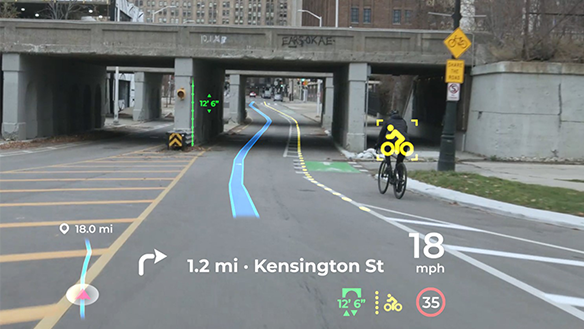January 11, 2021 – Today at CES 2021, Panasonic Automotive Systems of America (Panasonic Automotive) has introduced its new Augmented Reality (AR) heads-up display (HUD). Panasonic stated that it has utilized its latest advances in optics, volume optimization and imaging technology, combined with AI technology from its SPYDR cockpit domain controller to render near-field and far-field content for vehicle information, object and pedestrian detection, and mapping / route guidance, for a seamless, more engaged and informed driver experience.
“The HUD market is one of the fastest growing categories in mobility, but traditional HUDs only cover a small section of the road,” said Scott Kirchner, President at Panasonic Automotive and Executive Director, Panasonic Smart Mobility. “Panasonic’s AR HUD solutions cover more of the roadway, with traditional cluster content like speed and fuel in the near field as well as 3D overlays in the far field, showing navigation and other critical driver data mapping spatially to the road ahead. And in a future with more self-driving vehicles, our AR HUD could provide an important added level of comfort and assurance for AV passengers as well.”
Panasonic’s AR HUD system projects 3D, AI-driven key information into the driver’s line of sight to help reduce driver distraction and potentially increase safety on the road. Panasonic’s AR HUD development utilizes what the company calls a ‘PRIZM’ process to address a variety of driver needs:
- Precise placement – Optimal image positioning;
- Reflection – AI smart optical graphic road overlays for object / sign detection;
- Intuitive – Discriminates / prioritizes user focus on what is ahead, e.g. is that a deer or a box in the road?;
- Zonal- UX optimized field-of-view organizationally displays objects along the road;
- Mission Control – Dynamic imaging that brings visibility and the roadway together.

According to Panasonic, the key features of its new AR HUD include:
Eye tracking technology – Projects information at the driver’s level of sight based on the driver’s eye position, eliminating a potential mismatch between the projected image when the driver moves their head.
Advanced optics – Advanced optical design techniques provide expanded field-of-view (beyond 10 by 4 degrees) for virtual image distance of 10 meters or greater; detects pedestrians and objects through enhanced low light and nighttime view; tilted virtual image planes adjust visibility of objects in the driver’s field of view; embedded camera system allows discrete monitoring for the driver’s eye location.
AI navigation accuracy – AI-driven AR navigation technology detects and provides multi-colour 3D navigation graphics that adjust with the moving vehicle’s surroundings, displaying information like lane markers and GPS arrows where turns will occur and sudden changes such as collisions or cyclists in one’s path.
Vibration control – Panasonic’s proprietary camera image stability algorithm enables AR icons to lock onto the driving environment regardless of the bumpiness of the road.
Real-time situational awareness – Driving environment updates occur in real-time; Advanced driver-assistance systems (ADAS), AI, AR environment information updates in less than 300 milliseconds.
3D imaging radar – Sensor-captured full 180-degree forward vision up to 90 meters and across approximately three traffic lanes.
Compact size – Packaging to fit any vehicle configuration.
4K resolution – 4K resolution using advanced laser and holography technology, with static near-field cluster information and far-field image plane for AR graphic overlay.
Panasonic added that its strategic collaborations with emerging tech innovators have helped to provide added depth to the data-driven visuals in its AR HUD. These include: Dual plane, high-resolution laser holography from Envisics, developers of a patent-protected, dynamic holographic platform that enables true holography across multiple mobility applications (and which automotive company Hyundai is a significant investor); and 3D localization technology and AI navigation and situational awareness analytics from Phiar, developers of a patent-protected spatial-AI, AR navigation platform.
For more information about Panasonic’s new AR HUD, click here.
Image / video credit: Panasonic North America / YouTube
About the author
Sam Sprigg
Sam is the Founder and Managing Editor of Auganix. With a background in research and report writing, he has been covering XR industry news for the past seven years.




